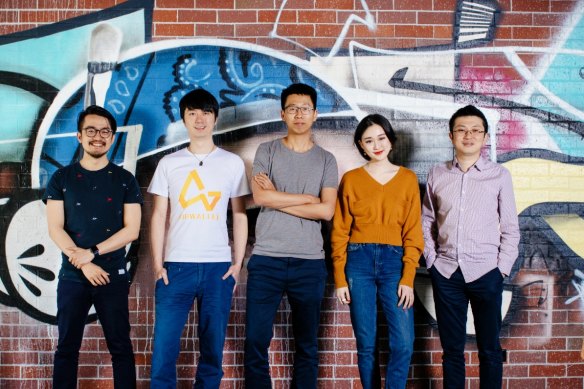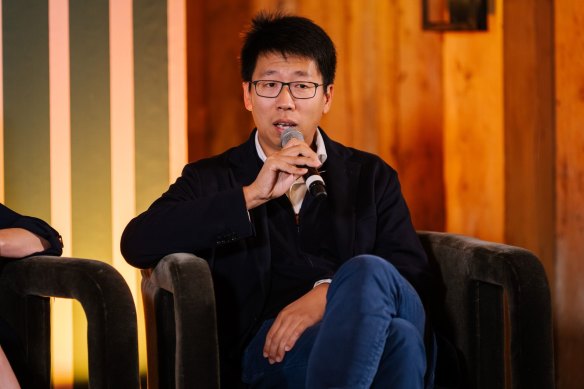
Each “Canvanaut” receive free breakfast, lunch and snacks from its in-house chefs, along with a gym membership, employee assistance programs, stock options and the option to join its social clubs such as Dance Club, Wine Club or Friday Foodies. “Atlassians” meanwhile receive an annual learning budget, health and life insurance, and paid days to volunteer at a charity.
Airwallex offers some perks including generous paid parental leave and subsidised yoga, but has come under scrutiny for its high-pressure culture, high turnover and gruelling work hours.
“Canva is just a lot bigger in size, and they have the resources to invest and are able to provide a better employee experience. We just don’t have the financial resource to do so, and I don’t have, personally, the time to do so,” Zhang said.

The founding team of Airwallex (from left): Max Li, Xijing Dai, Jack Zhang and Lucy Liu in 2017.Credit: AFR
“I think as you continue to scale the business, you have more resources, you have more financial support so that you’re more comfortable providing that sort of support.
“We want to build a high-performance culture, right? And we’re not a business that you can just come into, work for four hours a day and that’s it. You have to be reasonably ambitious, you have to be willing to put the hard work in, and you have to be enjoying this bit of a chaotic environment.”
Loading
The benefit of a lack of structure is that Airwallex employees have ample opportunity to grow, according to Zhang, who spent nearly a decade working as an engineer in banking, an environment he says now was stifling.
He said most of Airwallex’s senior leadership team had been internally promoted and had benefited from helping build a hyper-growth start-up, and that staff engagement had significantly improved over the past 12 months.
Airwallex is one of the nation’s most promising technology businesses. It’s one of just nine Australian-founded “unicorns” – billion-dollar privately held technology start-ups – and recently surpassed $US100 billion ($147 billion) in annual processing volume, up 73 per cent year-on-year. The company achieved cash flow positivity at the end of 2023, and now has $US100 million in funds under management for its “Airwallex Yield” product, which offers rates of more than double that of Australia’s big four banks.

Airwallex was most recently valued at $US5.5 billion in late 2022 after landing $US100 million in funding from investors including Square Peg, Salesforce Ventures, Sequoia Capital China, Tencent and Australian superannuation fund HostPlus.Credit: Bloomberg
Airwallex was most recently valued at $US5.6 billion in late 2022 after landing $US100 million in funding from investors including Square Peg, Salesforce Ventures, Sequoia Capital China, Tencent and Australian superannuation fund HostPlus, and its CEO Zhang now has an estimated wealth of $1.19 billion, according to the AFR’s 2024 rich list.
Despite the rapid expansion, Zhang said the company had to become more conservative in its approach amid the current high-interest rate environment. “Growth with profitability” is now the focus, rather than “growth at all costs”.
The fintech is chasing lofty goals, including a stated mission of building a single platform for both payments and finance to empower modern businesses to grow beyond borders, at Zhang puts it. “Think of us as like a modern HSBC, or Citibank, but instead of calling ourselves a bank, we actually build all of the financial infrastructure … The foundational building blocks driving innovation in Australia’s economy.”
More immediately, one of Airwallex’s next steps is a likely IPO and Zhang is now eyeing the second half of 2026 for a public listing, which he said would probably be on the New York Stock Exchange, given he’s based there.
Loading
“We’ll be approaching a billion in ARR [annual recurring revenue] next year and in 2026 it should be well over a billion,” he said. “We’d be a significant business going public, but we might not go. We always have that optionality because the company is profitable.”
He added that a float on the NYSE would not represent a slight against the ASX, which he said is home to some great technology businesses.
“I just don’t think it has the liquidity to support our long-term ambitions,” he said of the ASX. “You might have more pressure in the US, if the business is not doing well, your share price will tank a lot more.
“But the benefit is that when you need large amounts of liquidity, if you’re a tier-one company, you get the upside of that.
“We’ll be spending our next 12 months scaling up our marketing and brand awareness, and continuing to invest in better relationships with our customers.”
The Business Briefing newsletter delivers major stories, exclusive coverage and expert opinion. Sign up to get it every weekday morning.









 Add Category
Add Category